Re: Along The Gilpin Tramway - The Wood Mine.
Posted by Keith Pashina on Mar 06, 2025; 5:23am
URL: http://c-sng-discussion-forum.254.s1.nabble.com/Along-The-Gilpin-Tramway-A-Closer-Look-tp20380p20552.html
GUNNELL HILL (continued)
Continuing a detailed look at the Gilpin Tram's trackage and the mines served on Gunnell Hill, we'll continue where we last left off, at the Gunnell Mine. Next on the main line is the spur to the Grand Central mine.
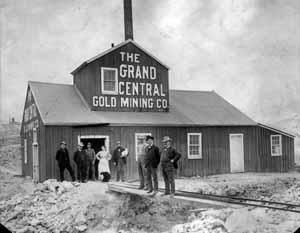
M.P. 40.49 East Whiting Spur:
This well-published photo is of the Grand Central Mine (or East Whiting), with the proud owners or promoters in front. The bridge is for the mine dump cars - they could dump into the Gilpin Tram spur below (the wide gauge?), or continue on to the waste rick dump. Note that when they painted the mine, they painted in a white trim board above the large doorway!
Back on the main line, and almost directly across the spur track number 2 to the Gunnell Mine, a short spur veered off of the east side of the main line, serving the East Whiting Mine, more commonly known as the Grand Central Mine.
The Grand Central was regular ore shipper on the Gilpin Tram, with surviving records of ore shipments being made in 1899 through 1904, 1906, and 1907. The “Daily Mining Investor” issue of September 11, 1905, gives a brief report: “S.T. Elliot, who has taken a lease and bond the Grand Central mine on Gunnell hill, starting preliminary work on the 15th inst., has succeeded in getting air through to the level to which the work will be pushed. Stoping has been started and Mr. Elliot is figuring on making the first shipment of ore on Monday or Tuesday of next week. When the mine is placed to proper condition between 15 and 20 men will be put to work.
The Grand Central has not been worked for the past year and a half and at that time was operated by the Grand Central Company. According to reports a large quantity of very high grade ore was taken out, and at one time the property was considered one of the rich producers of the camp. Mr. Elliott, who will have charge of the mine, understands the business thoroughly, having acted as foreman of the Smuggler Union in Telluride, a period of ten years, until about two years ago.”
Apparently, Mr. Elliott was successful, and was making ore shipments from the Grand Central Mine for at least 1906 and 1907. This mine could have shipped other years, but these are the only years for which I have seen written records of ore traffic. This is yet another example of how many mines in the region operate sporadically over the years, as investors and their money came and went.
There are traffic records shwoing ore shipments on the tram in years 1899 to 1904, and 1906 to 1907. There could be more, it just means there are records existing for those particular periods.
The Grand Central Mine is probably the best-known Gilpin County mine to model railroaders. This kit has been brought out by several kit manufacturers over the years, and in several scales. I think a kit is still available for this structure in HO, S and O from Trout Creek Engineering/Classic Miniatures.
There seemed to be ongoing disagreements between the tramway and some of the local wagon teamsters. The Gilpin Observer reported on June 7, 1906, “Complaint was lodged against Wm. Gumma in the county court last week…he is being charged by the Tramway company with the destruction of property. The Tramway company alleged that defendant had removed a section of track crossing Prosser Street. Gumma claimed at the point in question the track was so highly-elevated as to obstruct wagon traffic and make it impossible to drive over it. He removed several fish plates and hitched his team to the track and made an opening wide enough for his team to pass through.” Well, that sure showed them!
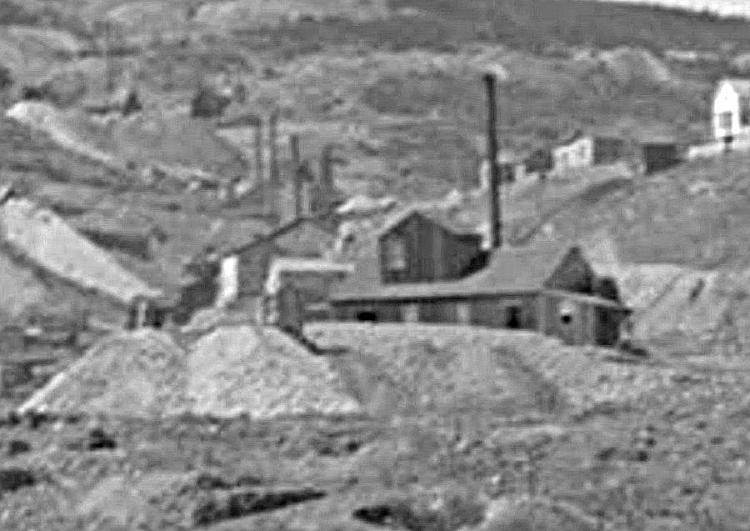
A blurry enlargement of a photo shows the Grand Central mine with its prominent waste rock dump. The outhouse is conveniently perched on the waste dump. Note that the mine name is not painted on the walls in this view. This image is from the Denver Public Library, Western History collection.
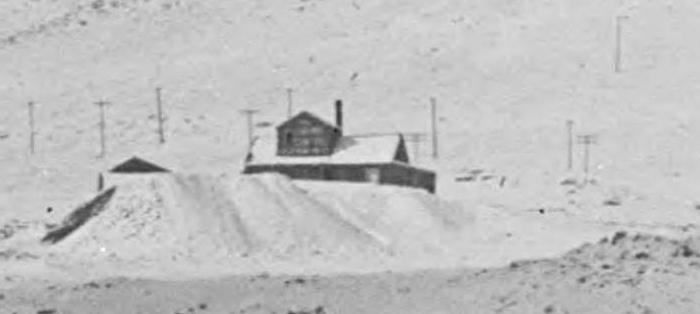
This image is also from the Denver Public Library, Western History collection. It shows the Grand Central from a more distant vantage point, and the painted name can still be seen on the roof cupola. No outhouse is visible on the waste rock dump. This image was taken between 1901-1910.
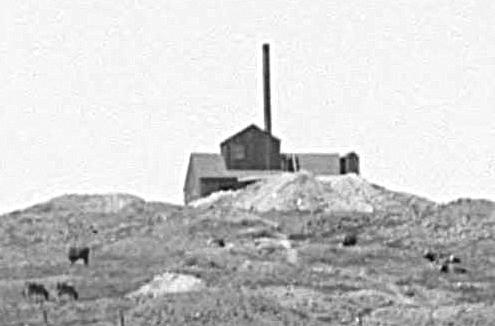
Another blurry enlargement from yet another photo shows the east side of the Grand Central. This pastoral scene has cattle grazing nearby. This image is also from the Denver Public Library, Western History collection.
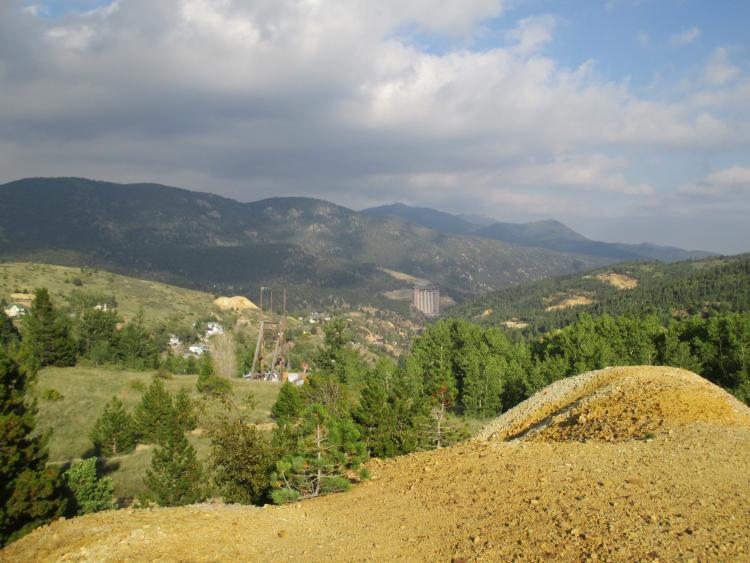
Today, nothing remains of the mine structure. The shaft is caved in, plugged, and only has a vent and USGS marker. The waste rock pile remains, and this is a view the site today, with Central City in the background. The mine waste rock dock visible at distant left center is the Freedom Mine site, which we looked at in previous posts.
URL: http://c-sng-discussion-forum.254.s1.nabble.com/Along-The-Gilpin-Tramway-A-Closer-Look-tp20380p20552.html
GUNNELL HILL (continued)
Continuing a detailed look at the Gilpin Tram's trackage and the mines served on Gunnell Hill, we'll continue where we last left off, at the Gunnell Mine. Next on the main line is the spur to the Grand Central mine.

M.P. 40.49 East Whiting Spur:
This well-published photo is of the Grand Central Mine (or East Whiting), with the proud owners or promoters in front. The bridge is for the mine dump cars - they could dump into the Gilpin Tram spur below (the wide gauge?), or continue on to the waste rick dump. Note that when they painted the mine, they painted in a white trim board above the large doorway!
Back on the main line, and almost directly across the spur track number 2 to the Gunnell Mine, a short spur veered off of the east side of the main line, serving the East Whiting Mine, more commonly known as the Grand Central Mine.
The Grand Central was regular ore shipper on the Gilpin Tram, with surviving records of ore shipments being made in 1899 through 1904, 1906, and 1907. The “Daily Mining Investor” issue of September 11, 1905, gives a brief report: “S.T. Elliot, who has taken a lease and bond the Grand Central mine on Gunnell hill, starting preliminary work on the 15th inst., has succeeded in getting air through to the level to which the work will be pushed. Stoping has been started and Mr. Elliot is figuring on making the first shipment of ore on Monday or Tuesday of next week. When the mine is placed to proper condition between 15 and 20 men will be put to work.
The Grand Central has not been worked for the past year and a half and at that time was operated by the Grand Central Company. According to reports a large quantity of very high grade ore was taken out, and at one time the property was considered one of the rich producers of the camp. Mr. Elliott, who will have charge of the mine, understands the business thoroughly, having acted as foreman of the Smuggler Union in Telluride, a period of ten years, until about two years ago.”
Apparently, Mr. Elliott was successful, and was making ore shipments from the Grand Central Mine for at least 1906 and 1907. This mine could have shipped other years, but these are the only years for which I have seen written records of ore traffic. This is yet another example of how many mines in the region operate sporadically over the years, as investors and their money came and went.
There are traffic records shwoing ore shipments on the tram in years 1899 to 1904, and 1906 to 1907. There could be more, it just means there are records existing for those particular periods.
The Grand Central Mine is probably the best-known Gilpin County mine to model railroaders. This kit has been brought out by several kit manufacturers over the years, and in several scales. I think a kit is still available for this structure in HO, S and O from Trout Creek Engineering/Classic Miniatures.
There seemed to be ongoing disagreements between the tramway and some of the local wagon teamsters. The Gilpin Observer reported on June 7, 1906, “Complaint was lodged against Wm. Gumma in the county court last week…he is being charged by the Tramway company with the destruction of property. The Tramway company alleged that defendant had removed a section of track crossing Prosser Street. Gumma claimed at the point in question the track was so highly-elevated as to obstruct wagon traffic and make it impossible to drive over it. He removed several fish plates and hitched his team to the track and made an opening wide enough for his team to pass through.” Well, that sure showed them!

A blurry enlargement of a photo shows the Grand Central mine with its prominent waste rock dump. The outhouse is conveniently perched on the waste dump. Note that the mine name is not painted on the walls in this view. This image is from the Denver Public Library, Western History collection.

This image is also from the Denver Public Library, Western History collection. It shows the Grand Central from a more distant vantage point, and the painted name can still be seen on the roof cupola. No outhouse is visible on the waste rock dump. This image was taken between 1901-1910.

Another blurry enlargement from yet another photo shows the east side of the Grand Central. This pastoral scene has cattle grazing nearby. This image is also from the Denver Public Library, Western History collection.

Today, nothing remains of the mine structure. The shaft is caved in, plugged, and only has a vent and USGS marker. The waste rock pile remains, and this is a view the site today, with Central City in the background. The mine waste rock dock visible at distant left center is the Freedom Mine site, which we looked at in previous posts.
Keith Pashina
Narrow-minded in Arizona
Narrow-minded in Arizona
| Free forum by Nabble | Edit this page |